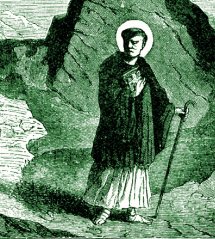Lives of the Saints
Our Models and Protectors
Spiritual Bouquet:
November 27

Saint Maximus
Bishop of Riez
(† 460)
Saint Maximus, from his youth as the son of a noble Christian family, manifested a firm predilection for virtue. His austerities, undertaken to conserve his virtue at all costs, were so constant and determined that it seemed he merited the crown of martyrdom even without a tyrant to persecute him. For seven years, after he made a private vow of virginity at the age of eighteen and then entered into religion, he was a disciple of Saint Honoratus, Abbot of the famous monastery on the island of Lerins; and in the year 426 he succeeded in that office his master, who had been chosen bishop of Arles.
For seven years, he governed this monastery, and under his guidance, solid piety and penance flourished as well as excellent studies, which he established and directed himself. The demon, irritated, under various disguises persecuted him without respite, but the holy Abbot put him to flight by the sign of the Cross, our salvation. Saint Maximus was remarkable not only for the spirit of recollection, fervor, and piety familiar to him from childhood, but still more for the gentleness and kindliness with which he governed the fervent monks of this monastery. At that time it contained a very large number of them. Exhibiting in his own person an example of the most sterling virtues, his exhortations could not fail to prove all-persuasive; loving all his religious, whom it was his delight to consider as composing one single family, he established among them the sweet concord, union, and holy emulation in virtue which render the exercise of authority virtually unnecessary, and make holy submission a pleasure.
The clergy and people of Antibes near Lerins, then those of Frejus, moved by such a shining example, elected Maximus for their bishop, but he refused this dignity verbally on the first occasion, and on the second took flight in a boat and then into a forest, where he prayed for three days and nights that the Lord would change the dispositions of the people of Frejus. Their emissaries did not succeed in finding him, and proceeded to another election. He fled again after Saint Hilary joined his approbation to the election of the clergy and people of the city of Riez in the French Alps, then large and heavily populated. This time he was found, and was compelled to accept the see of Riez, his native diocese.
When one day a church was to be built on a hilltop and it was necessary to transport heavy columns to the elevated site, the oxen refused to move. The bishop was absent that day, although he had often come to encourage all concerned. The people attached two more animals to the yoke, but still none of them moved. The bishop was advised, and when he arrived told them he saw a demon standing before the oxen to prevent their advance. He put the enemy to flight once more with the sign of the Cross, and himself detached the two animals who had been requisitioned; and the first two, with his blessing, had no difficulty in arriving at the hilltop.
In the see of Riez Saint Maximus practiced virtue in all gentleness until he died in 460, regretted as the best of fathers.
Les Petits Bollandistes: Vies des Saints, by Msgr. Paul Guérin (Bloud et Barral: Paris, 1882), Vol. 13; Little Pictorial Lives of the Saints, a compilation based on Butler's Lives of the Saints and other sources by John Gilmary Shea (Benziger Brothers: New York, 1894).